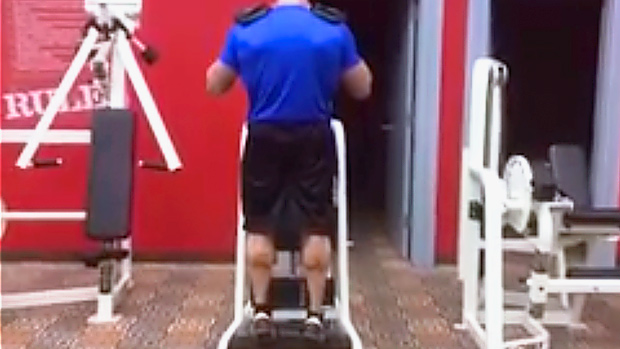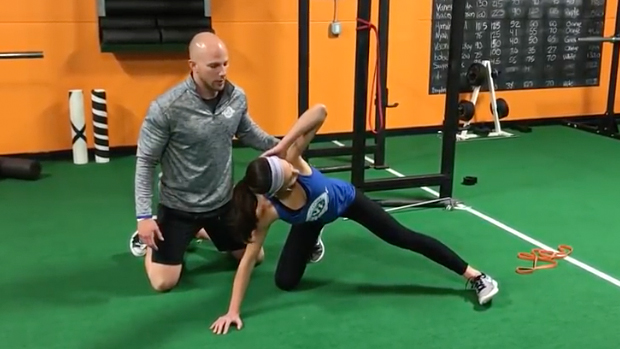Within the realm of training for greater strength, muscle mass, and endurance lies an area of science that remains relatively untapped: Neuroscience. It's indeed the uncharted waters in the vast ocean of the science and practice of resistance training. That's because so little is known about how the nervous system actually works.
Indeed, neuroscientists have yet to figure out how information in your brain is stored, processed, and retrieved. What exactly does that mean, anyway? It means we're not sure how your brain stores the phone number from that busty fitness bunny you met at the gym.
 |
And when you need to recall her number because your old man left you the keys to his lime green Prius, we don't know how your brain is doing it. A few neuroscientists have a few muddy ideas, but there are still too many unknowns to clean and jerk those neural processes out of ambiguity.
So it's not surprising to learn that little is known about the relationship between the nervous system's control of skeletal muscle and how we can improve its function to build bigger muscles and bigger lifts.
But don't fret yet, Brett. Neurologists have accumulated a pretty respectable sample of studies over the last 50 years that help elucidate just how damn powerful your brain, spinal cord, and associated neurons really are to control and develop your strength and muscles. So I'm here to take you through some landmark neuroscience studies that make me drool like a perv at a peepshow.
I drool, yes I do. I drool because I know the next few decades are going to uncover my postulate that the nervous system is what's holding us back from developing strength and muscle beyond our wildest dreams.
Why I Believe The Nervous System is the Key
1. Nerve Controls Muscle – You have muscles that are classified as fast or slow. These muscles are matched up with nerves that are either fast or slow, too. So, by nature, a fast muscle has a fast nerve, and a slow muscle has a slow nerve.
But what happens when you pull a fast nerve out of its muscle and insert the fast nerve into a slow muscle? The muscle takes on fast characteristics. Voila! This process, known as cross innervation, demonstrates that nerve controls muscle. We can thank Eccles and his colleagues, along with Salmons and Sreter, for these demonstrations because their studies are probably the most significant demonstrations of the power that nerves have over muscles. (1, 2)
It wasn't, however, until 1998 before this concept was taken a step further. Before I get to the next study and what it demonstrated, I want to give you a brief lesson in the physiology of muscle hypertrophy.
 |
New proteins that cause hypertrophy are produced in the nucleus of your muscle cells. The intent of resistance training is to break down muscle proteins so your body will send a signal to create more proteins. Over the course of months, this creation and insertion of new proteins in your muscles is what causes visible muscle growth. And what enters the nucleus to signal new protein formation is known as a transcription factor.
In 1998, Chin et al demonstrated that the rate of nerve firing into the muscle determined whether fast or slow muscle proteins were formed. During periods of slow nerve activity, a specific transcription factor (NFAT) enters the nucleus and induces slow fiber formation. (3) My iteration is this: when NFAT enters the nucleus of a muscle, slow fibers are formed.
In a fast muscle, its fast nerve activity keeps this same transcription factor (NFAT) from entering the nucleus. The result? Slow muscle fibers aren't formed and the fast muscle can keep making more fast muscle fibers. That's good because fast muscles can produce more force, and they're thought to grow larger than slow muscles.
In essence, the Chin et al study demonstrated why slow nerves and slow muscles go together, and why fast nerves and fast muscles go together (their nerve activity is correlated with their specific muscle fiber formation). But as a philosopher, trainer, and lifter, I want to know what I can do with this information to build bigger, stronger muscles.
And this, my friends, is where I take an enormous leap of faith.
You see, I preach the importance of fast muscle contractions for a variety of reasons. One of the reasons is because of a study by Desmedt and Godaux. They demonstrated that fast muscle contractions activated motor units earlier; and fast contractions activated approximately three times as many motor units as slow contractions.(4) But I'm also taking what I learned from the previous studies and apply it to strength and hypertrophy training.
Here's What I'm Hoping the Future Will Show: Fast muscle actions cause more fast muscle fibers to be formed by blocking slow muscle fiber formation in the nucleus, thus allowing us quicker strength and muscle gains.
Early Intermission
Up to this point, I attempted to explain what happens when you switch nerves and muscles. And I touched on what type of muscle proteins are formed in response to slow or fast nerve activity. Those are direct correlations between nerve and muscle.
This next section, however, touches on the relationship between strength gains that occur in muscles that aren't even stimulated by their associated nerves. In other words, if you really want to see some amazing demonstrations for the power of your brain, the power of your neighboring muscles, and the power of your central nervous system, keep reading.
2. Our Brain Makes our Muscles Stronger – My all-time favorite neuroscience study was performed by Yue and Cole in 1992. I carry this study around with me like Ben Affleck must carry around his Oscar from Good Will Hunting. When I'm feeling hungry or lonely, I suckle on the page corners like a newborn pig suckles on his mama's tit. And once while in a state of inebriation, I put a wig on it and... .okay, I better stop there.
What's so mesmerizing, alluring, and radical about the Yue and Cole study? Well, they had two groups of people "perform" a strength training protocol. The first group trained their left hand muscles for 5 sessions per week for four weeks. Like any reputable study on strength enhancement, the movement had to be isolated and simple to eliminate other complex variables that occur with larger motor tasks. Basically, they abducted their left pinky finger against resistance.
 |
Powerful pinky!
The other group? They imagined doing the same movement with the same effort and frequency. Yes, you read that right: they simply thought about the exercise, but didn't move a muscle. And just to make sure that they didn't move a muscle, the researchers hooked them up to an EMG to make sure they weren't producing any force whatsoever.
Now, for the shocking part: At the end of the study, the group that actually performed the contractions against resistance increased their strength by 30%. But the "imagined contraction" group increased their strength by 22%! (5)
I still get chills when I think about what that study demonstrates.
This is about as close to a holy grail as a neurophysiologist like me will ever find. I mean, think about that protocol and its implications. It means that we can significantly improve our strength without even contracting our muscles!
How does this happen? We really don't know. Remember what I said in the beginning, there's so much we don't know about even the most common neural tasks such as storing and recalling memories. But it's likely that by thinking about a specific movement, we're priming our descending pathways so our muscles at the end of the pathway will receive more stimulation (greater motor unit recruitment) once we actually perform the movement.
Then again, the adaptation could be limited to our higher brain centers. A committee of brain areas work together before sending a signal down your spinal cord and out to your muscles. That "committee" might get stronger when we think about a movement on a regular basis. We really don't know, but we know that our mind can improve our strength.
How To Apply This Information: It probably goes without saying, but you should make an effort to think... I mean, really think through the lifts you're trying to improve the most. When you're not in the gym, think about your squat, deadlift, bench press, and clean and jerk form. Think about the form for whatever movements you need to improve the most. And I'd be willing to take another leap of faith and say that by imagining your movements outside of the gym in a quiet room, it might help you add mass.
Want bigger calves? Train them hard, fast, and heavy in the gym. And when you're not in the gym, take time during the day to really concentrate on the calf movements you perform. With your mind focused, feel the burn in your calves, imagine the load on your calves, and picture your calves growing. The greatest bodybuilders and trainers often point to the power of the mind for building bigger, stronger muscles. These imagined contractions could very well be one of the keys. I believe that such imagined contractions will augment your results in the gym.
 |
3. You Can Get Significantly Stronger without Getting Bigger – We all want to be big and strong. Some of us are genetically blessed with lots of muscle mass, and others (including this writer) must cuss, scream, and bleed their way to every ounce of new muscle. But one thing's for certain: we all know we can get much stronger without getting bigger. And this is an important key to understanding the nervous system.
One of the top neuroscientists in the field of motor unit recruitment and strength adaptations is Dr. Roger Enoka. Here's what he had to say about the relationship between strength and muscle size:
"Although the maximal force which a muscle can exert is directly related to its cross-sectional area, there is a poor correlation between increases in strength and muscle size." (6)
Here's how I translate what he said: If you take two, untrained 25 year-old males and test their maximal strength, it's likely that the guy who has naturally bigger quadriceps will be able to produce more force in a leg extension test. But if you compare the size of the quadriceps between two, highly-trained 25 year-old males, their size won't determine who's stronger.
That's because strength is a complex entity that's affected by neural, mechanical and muscular factors. In other words, out of the three factors that can increase strength, only one is dependent on hypertrophy, and even that's debatable. It appears you can augment muscular factors that increase strength but aren't necessarily dependent on hypertrophy. What I'm referring to are proteins that attach your contractile proteins to the Z-disc of your muscle's sarcomere.
How to Apply this Information: My position is that you should always strive to improve your performance in the gym. If you're not providing a new, challenging stress by attempting to add more weight, lift faster, and/or increase the training volume, you won't build bigger and stronger muscles.
Training for maximal strength is a great way to add more muscle, but you must provide your muscles with enough training volume to elicit a hypertrophy response. After all, that's why I mentioned that there's a poor correlation between size and strength. In my view, the studies that didn't show a correlation between the two simply didn't use a high enough training volume, intensity, or frequency.
Merely getting stronger will not make you bigger. If you're training to get stronger, but you're not getting bigger, you need to eat more calories, increase your training frequency, and/or increase your training volume. I've compiled the guidelines for sufficient training volumes in my Set-Rep Bible article.
4. We Have Brakes on our Muscles – After studying the nervous system's role in human strength and performance, I've come to this conclusion: Our nervous system has the brakes set on our muscles' capabilities. Think of a high-performance sports car: if the emergency brake is partially on, it won't be able to perform at its maximum potential. The same is true with your nervous system's control over your muscles.
Why is this so? The answer is undoubtedly more complex than any team of neuroscientists could ever uncover, but the simplest answer is probably because of protective mechanisms. Our body doesn't want to be damaged or hurt in any way, shape or form. That's why we can't help but squint and flinch when an unexpected object comes flying at our precious eyeballs. And that's why we damn near piss ourselves when someone unleashes an air horn behind us while we're reading a book. Both of those actions mimic life-threatening situations that our ancestors had to survive – actions such as dodging an oncoming raptor or running from the vicious roar of a hungry beast.
In other words, we have thousands of year's worth of survival reflex mechanisms hard-wired into our nervous system. Building bigger biceps wasn't important for survival, and neither was squatting triple your body weight. So what we must do is find ways to release the brake that our nervous system is putting on our muscles. If we do, we can tap into motor units and contractile proteins that will accelerate our size and strength beyond belief. But this "unbraking" must be gradually systematic – if it's not, we'll tear our muscles and joints to shreds.
Case in point: If your son, daughter, or mistress was trapped underneath your car, you could immediately release this brake that I'm referring to. Yep, you could probably lift up the back end of the car even though you couldn't ordinarily deadlift 600 pounds. Your brain is the commander of your nervous system, and if your brain decides that you must deadlift 600 pounds of Chevrolet to untrap your daughter, you'll be able to do it. (It's likely, however, that your lower back will remind you over the course of 3 months while you're in physical therapy.) So as I said, we must release the brake slowly.
How to Apply This Information: The first step is to find whatever motivates you to build a bigger, stronger body and constantly remind yourself of whatever it is. Studies have demonstrated that motivation causes people to immediately increase their maximal strength.(7) In other words, being motivated will help release the brake.
The next steps take place in the gym. There are two techniques that work well to ease the brake off your muscles by tricking your nervous system. The first, and one that I've discussed many times, is the supramaximal hold that causes postactivation potentiation. Check out my Primed For Muscle article for more information.
The second option, heavy 1/4 reps, works through a similar neural mechanism. This is as simple as it sounds: lift the heaviest load you can handle for the strongest 1/4 of any movement. Keep in mind, the 1/4 portion that's naturally strongest will differ depending on what movement you're performing. Examples are the last 1/4 before lockout for the squat, deadlift, military press, dip, and bench press. For exercises such as curls, pull-ups and rows, you'll only be moving the load through the first 1/4 of flexion.
 |
The advantage of 1/4 reps is that they allow massive loads that force your nervous system to recruit more motor units. However, no bragging rights will ever be won by doing heavy 1/4 reps for every workout. Limit 1/4 reps to one workout each week. Here's a total body routine that works great to help release the brake on your muscles.
Sets: 3
Reps: 3 reps for 1/4 of the movement
Load: The heaviest weight you can handle
Rest: 90s between movement pairings (A1, rest 90s, A2, rest 90s, A1, rest 90s, A2, etc.)
A1. 1/4 Squat
A2. 1/4 Leg Curl
B1. 1/4 Dip
B2. 1/4 Chin-up
C1. 1/4 Seated Military Press
C2. 1/4 Incline Hammer Curl
D1. 1/4 Standing Calf Raise
D2. 1/4 Romanian Deadlift
Conclusion
That's it for now. I encourage you to read through this article a few times and really think about how the nervous system controls your muscles. If you open up your mind a little and think about the studies I referenced, you'll develop a greater appreciation for the elusive nervous system and all its wonders.
1. Buller AJ, Eccles JC, Eccles RM. J Physiol (Lond) 150:419, 1960.
2. Salmons S, Sreter FA. Nature 263:30-34, 1976.
3. Chin et al. Genes Dev12:2499-2509, 1998.
4. Desmedt JE, Godaux E. J Physiol 264:673-693, 1977.
5. Yue G, Cole KJ. J Neurophysiol 67(5):1114-1123, 1992.
6. Enoka R. Sports Med6:146-168, 1988.
7. Bigland-Ritchie B. Clinics in Chest Medicine 5:21-34, 1984.




